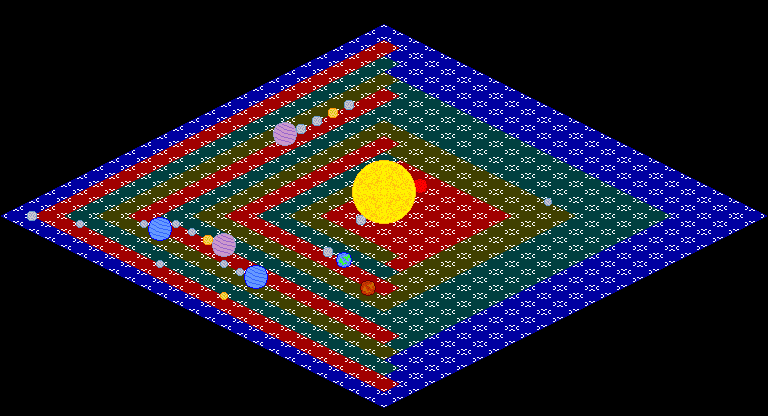First, the concept. From a Galaxy, to a Neighbourhood, to a Solar System, to a Planet, to a Kingdom, to Civilisation, to an Individual in role playing style. At all points in the game, it is designed to bring an open-ended-ness that many of us didn't really get from games like Spore that were still quite revolutionary, just didn't pack much of a punch in actual gameplay.
Secondly, my devotion and interest in it. I've always wanted to do a "Multi-User Dungeon" program and never lasted long enough in its conception to warrant a second or third day of development.
Finally, The scale of the project, which only gets bigger and bigger every time I decide to work on it (see below!). The idea of finishing it is more than a dream than finishing something like Wargames, its just probably not going to happen! By that of course, I'm referring to the chance of always finding something new to update or add to bring extra detail.
Moving the project to Isometric has given me half a dozen new ideas on what to do. One of my intentions was to develop it to also create a virtual "map" of the Universe as we know it. I have a fascination of Extrasolar planets, also known as Exoplanets, not so much about visiting any, but rather the rawness of the data collected that we assume upon. We don't even have a decent photographic picture of Pluto, yet we've still managed to find roughly 490 planets outside of our Solar system largely by how our mathmatical data of outside stars changes as these objects pass by it during its regular orbit.
It makes sense to start this map with our own Solar System, I've relied on this to gauge what kind of screen, grid and pixel size to make the game. The original conception was a 21x21 grid of a 24x24 pixel base, a quite strange size which I realised soon after might have been a little too constricting. I've stuck this time to a 32x32 pixel base for isometric, and I am trying out a 24x24 grid.
Because of the ability in isometric to easily emulate an idea of perception, I've moved away from my previous idea of the static planetary formation based on grid distance from the star(s) idea and instead opted for a moving planetary formation in which planet type and size make up for a lack of a true scale representation of a solar system (something that was never really possible in a 2D environment anyway).
You can already see the improvements I've made. Here is what it looked like before:

And after:

I'm using a modified version of the "Hot, Medium, Cold" system. The right side shows the new system which takes into account Gas Giant formation (Jupiter, Saturn, Uranus, Neptune) and "Deep" Space (Pluto to Eris) splitting the Cold section into two. The left side has been altered to show orbital paths for testing purposes but won't remain in the game (ie, it'll simply mirror the right side). Planets are also not shown in their climate colours, but rather to some degree their Atmosphere and planetary composition.
Distance is no longer relative, as mentioned above before with some planets taking up the same "ring" despite their real life distances being quite varied. For example, Earth is on the 4th ring even though it is only 1 Astronomical Unit (AU) from the Sun with Mercury and Venus being on two different rings themselves. Jupiter and Saturn are on the same ring, even though they are 5.2 and 9.5 AU from the Sun. The new system also presents better ability to represent Moons. In the old system, it was rare to find a planet capturing 1 moon, let alone 2 due to my attempts to represent distance. This time, there is greater allowances to show more. Finally, as part of the now-moving solar systems in the game, planetary years (the time it takes to go round the Sun) is now factored in as juicy extra. This would be important in late game where civilisations discover planets through astrology and later space colonisation, bringing some sense of "distance" without having it represented so dramatically on the map.
I have decided that another level of display might be needed, namely to represent the true number of moons around certain planets. As the above screenshot shows planets moving around the Sun, the next stage down should show the full number of moons moving around the planet. This will probably be more accurate in terms of distance too, and might be a great chance to make some kind of close-combat space battles or space exploration once I've done the one billion and one other things needed to get that far in the first place.
As my final piece of this already LONG post what was simply supposed to explain the following, I've uploaded the Solar System model shown above: it runs automatically and will spin the planets around their respective rings at a rate that will get them round the Sun relative to their real-universe equivalent years. Earth will move roughly ever 1.3 seconds, while Mercury will move every 0.7 seconds and Eris every 4 minutes.
Download it here: http://www.byond.com/games/Acebloke/Dreamland
You can sit and watch it move, knowing that one day Solar systems YOU created will be doing similar things. Please note that this model includes NO gameplay, so its running as intended. I'll likely update this again when the Planetary focus idea I mentioned above is included, so you can click on planets like Jupiter and see their full complement of tiny moons that simply can't fit on the solar system model.
(This has been farrrr too much writing, so this is it for today :p).